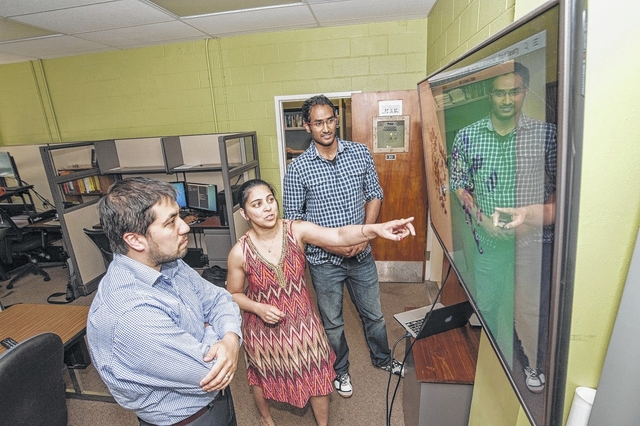CLEMSON — A sensor in development at Clemson University could help search for some of the globe’s most potentially destructive weapons to keep them out of the hands of terrorists and rogue nations.
Mark Blenner and Sapna Sarupria, both assistant professors in the College of Engineering and Science, are working to create a sensor that would pick up signatures of tributyl phosphate, a solvent used to enrich uranium, including for use in a nuclear weapon.
Enzymes can detect tributyl phosphate signatures, but researchers must find a way to lengthen the enzymes’ lifespans to make them more practical for sensors. Blenner and Sarupria are aiming to do so over the next three years with $487,000 from the Defense Threat Reduction Agency.
“The technology is there to do this in the near term,” Blenner said. “What’s missing is what our proposal addresses. It’s understanding how to make these devices work reliably for long periods of time. The thing that goes bad most frequently is the biological component — the enzyme that’s responsible for the detection.”
Blenner and Sarupria, who are both faculty members in the department of chemical and biomolecular engineering, are coming at the enzyme challenge from two different angles.
While Blenner does experimental work in a lab, Sarupria is using her expertise to create complex computer simulations of how the enzymes will react in various situations.
“It allows us to get a very detailed picture,” Sarupria said. “Because of the simulations, we can look at a single atom at a time and begin to observe the behavior. It allows us a very high resolution, which then allows us to find those underlying principles.”
Researchers envision a small, discreet sensor that could rapidly and accurately detect tributyl phosphate signatures at distances sufficient for investigators to make crucial decisions. They hope to create a sensor that could be deployed remotely, possibly disguised as a leaf, or attached to a uniform.
For researchers, the key challenge will be coming up with a strategy to immobilize enzymes on a polymer-coated surface, where the chemical signal gets turned into an electric signal and goes to a computer.
“We’re really trying to understand the underlying molecular-level properties of the enzyme and the characteristics that lead to this behavior so that we can look at it more generally rather than having to find a solution each time we use a different enzyme,” said Blenner, who is the principal investigator.
“We want to find general principles that allow us to make smarter decisions about how to develop these systems to begin with.”
The research could also lead to a better fundamental understanding of enzymes that would be useful in the pharmaceutical and chemical industries and biotechnology.
Douglas E. Hirt, chair of the chemical and biomolecular engineering department, said the collaboration can lead to new discoveries.
“Bringing together experimental and simulation techniques lays the groundwork for innovative solutions,” said Hirt, who is also serving as associate dean for research and graduate studies in the College of Engineering and Science. “Drs. Blenner and Sarupria are to be commended for this collaboration.”
Blenner and Sarupria have both recently won significant awards.
Blenner received the NASA Early Career Faculty Award and an award through the Air Force Office of Scientific Research Young Investigator Program.
Sarupria received an American Chemical Society OpenEye Outstanding Junior Faculty Award. She also received the Doctoral New Investigator Award from ACS Petroleum Research Fund.


